Developing Manager: Career Development Plan in Hospitality Mgmt
VerifiedAdded on 2024/05/17
|19
|5098
|430
Report
AI Summary
This report provides a comprehensive career development plan focusing on managerial skills within the hospitality and service context, particularly referencing TUI (Tourist Union International). It begins by comparing different management styles (Laissez Faire, Democratic, and Autocratic) and discussing essential leadership characteristics such as sociability, determination, intelligence, self-confidence, and integrity. The report evaluates the communication process, emphasizing the importance of effective communication in organizations. It analyzes organizational culture and change, highlighting various factors and structures. Furthermore, the report assesses personal management skills, strengths, weaknesses, opportunities, and threats, setting objectives for personal development. It details how to lead and motivate a team to achieve goals, justifying managerial decisions and recommending improvements. Finally, it explains how managerial and personal skills support career development, reviewing career needs and future requirements to produce a detailed development plan. The document is a solved assignment contributed by a student and available on Desklib.
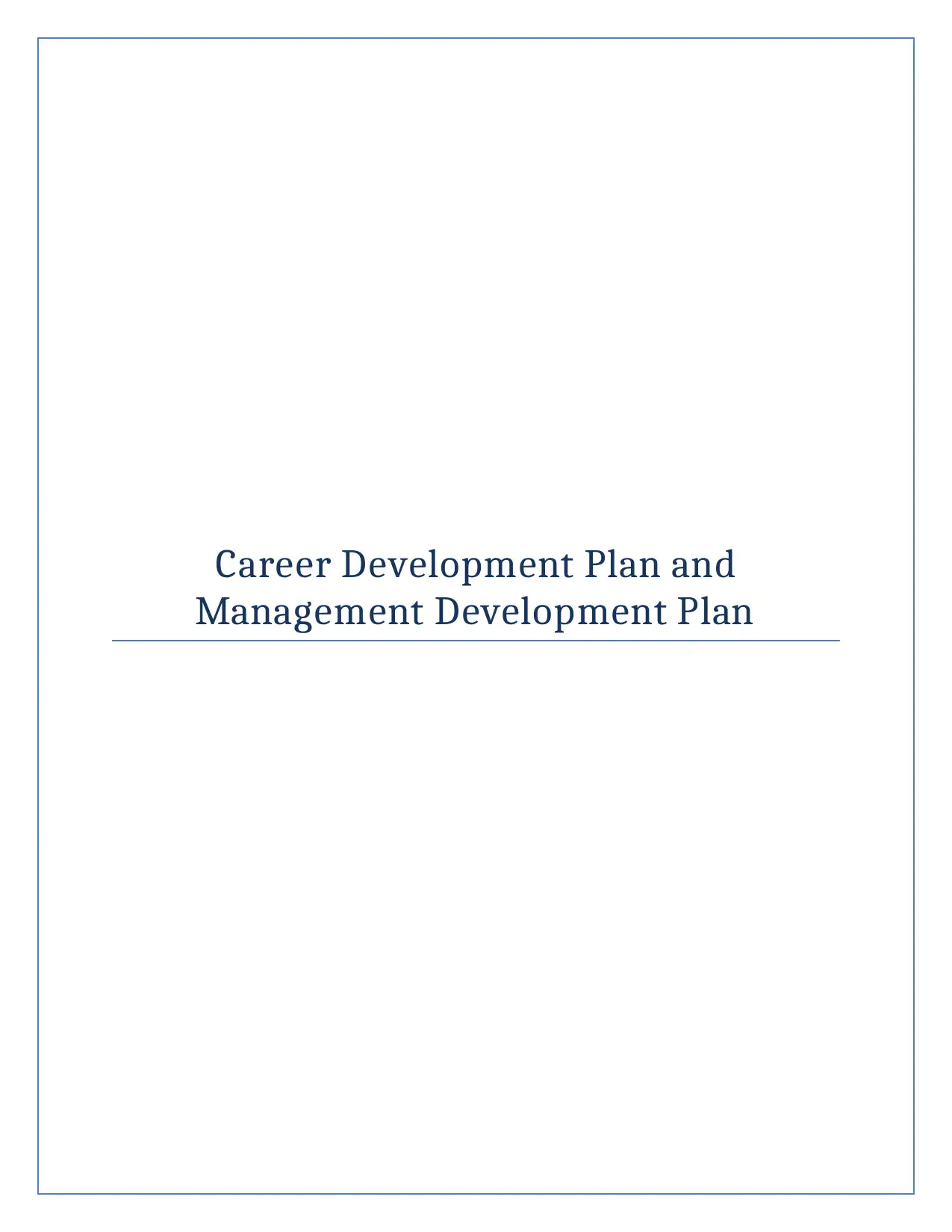
Career Development Plan and
Management Development Plan
Management Development Plan
Paraphrase This Document
Need a fresh take? Get an instant paraphrase of this document with our AI Paraphraser

Table of Contents
Introduction......................................................................................................................................3
Task 1: Understand the principles and practices of management behavior (964)..........................3
1.1 Compare different management styles......................................................................................3
1.2 Discuss leadership characteristics..............................................................................................4
1.3 Evaluate communication process in selected business..............................................................5
1.4 Analyze Organizational culture and change in selected business..............................................6
Task 2:.............................................................................................................................................7
2.1 Assess own management skills performance............................................................................7
2.2 Analyze personal strengths, weaknesses, opportunities and threats..........................................9
2.3 Set and prioritize objectives and targets to develop own potential.........................................10
Task 3.............................................................................................................................................12
LO3 be able to show managerial skills within a business and service context.............................12
3.1 lead and motivate a team to achieve an agreed goal or objective............................................12
3.2 justify managerial decisions made to support achievement of agreed goal or objective and
recommendations for improvements.............................................................................................13
Task 4.............................................................................................................................................14
LO4 be able to create a career development plan for employment within a business and service
context............................................................................................................................................14
4.1 explain how own managerial and personal skills will support career development................14
4.2 review career and personal development needs, current performance and future needs to
produce development plan.............................................................................................................15
Conclusion.....................................................................................................................................17
Reference.......................................................................................................................................18
Introduction......................................................................................................................................3
Task 1: Understand the principles and practices of management behavior (964)..........................3
1.1 Compare different management styles......................................................................................3
1.2 Discuss leadership characteristics..............................................................................................4
1.3 Evaluate communication process in selected business..............................................................5
1.4 Analyze Organizational culture and change in selected business..............................................6
Task 2:.............................................................................................................................................7
2.1 Assess own management skills performance............................................................................7
2.2 Analyze personal strengths, weaknesses, opportunities and threats..........................................9
2.3 Set and prioritize objectives and targets to develop own potential.........................................10
Task 3.............................................................................................................................................12
LO3 be able to show managerial skills within a business and service context.............................12
3.1 lead and motivate a team to achieve an agreed goal or objective............................................12
3.2 justify managerial decisions made to support achievement of agreed goal or objective and
recommendations for improvements.............................................................................................13
Task 4.............................................................................................................................................14
LO4 be able to create a career development plan for employment within a business and service
context............................................................................................................................................14
4.1 explain how own managerial and personal skills will support career development................14
4.2 review career and personal development needs, current performance and future needs to
produce development plan.............................................................................................................15
Conclusion.....................................................................................................................................17
Reference.......................................................................................................................................18
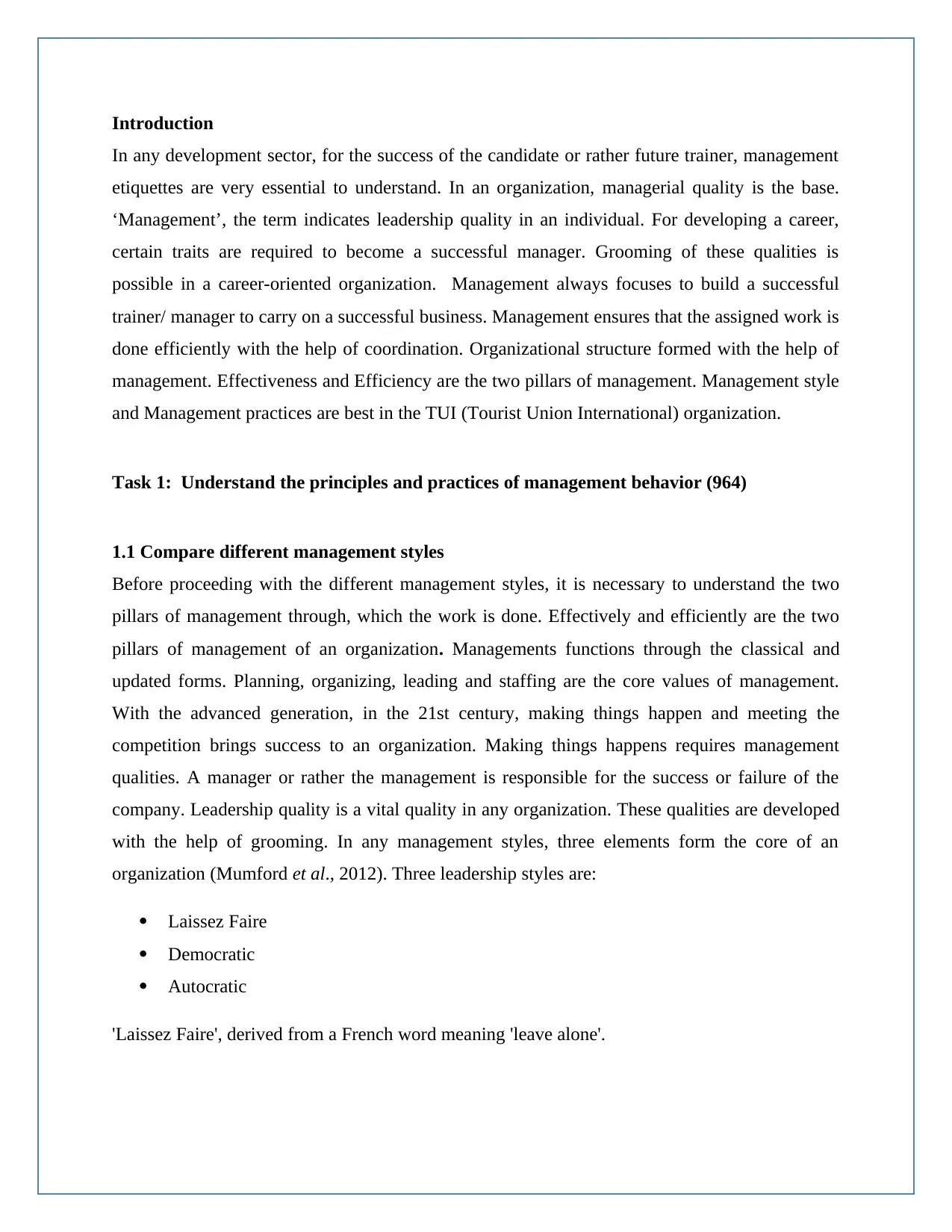
Introduction
In any development sector, for the success of the candidate or rather future trainer, management
etiquettes are very essential to understand. In an organization, managerial quality is the base.
‘Management’, the term indicates leadership quality in an individual. For developing a career,
certain traits are required to become a successful manager. Grooming of these qualities is
possible in a career-oriented organization. Management always focuses to build a successful
trainer/ manager to carry on a successful business. Management ensures that the assigned work is
done efficiently with the help of coordination. Organizational structure formed with the help of
management. Effectiveness and Efficiency are the two pillars of management. Management style
and Management practices are best in the TUI (Tourist Union International) organization.
Task 1: Understand the principles and practices of management behavior (964)
1.1 Compare different management styles
Before proceeding with the different management styles, it is necessary to understand the two
pillars of management through, which the work is done. Effectively and efficiently are the two
pillars of management of an organization. Managements functions through the classical and
updated forms. Planning, organizing, leading and staffing are the core values of management.
With the advanced generation, in the 21st century, making things happen and meeting the
competition brings success to an organization. Making things happens requires management
qualities. A manager or rather the management is responsible for the success or failure of the
company. Leadership quality is a vital quality in any organization. These qualities are developed
with the help of grooming. In any management styles, three elements form the core of an
organization (Mumford et al., 2012). Three leadership styles are:
Laissez Faire
Democratic
Autocratic
'Laissez Faire', derived from a French word meaning 'leave alone'.
In any development sector, for the success of the candidate or rather future trainer, management
etiquettes are very essential to understand. In an organization, managerial quality is the base.
‘Management’, the term indicates leadership quality in an individual. For developing a career,
certain traits are required to become a successful manager. Grooming of these qualities is
possible in a career-oriented organization. Management always focuses to build a successful
trainer/ manager to carry on a successful business. Management ensures that the assigned work is
done efficiently with the help of coordination. Organizational structure formed with the help of
management. Effectiveness and Efficiency are the two pillars of management. Management style
and Management practices are best in the TUI (Tourist Union International) organization.
Task 1: Understand the principles and practices of management behavior (964)
1.1 Compare different management styles
Before proceeding with the different management styles, it is necessary to understand the two
pillars of management through, which the work is done. Effectively and efficiently are the two
pillars of management of an organization. Managements functions through the classical and
updated forms. Planning, organizing, leading and staffing are the core values of management.
With the advanced generation, in the 21st century, making things happen and meeting the
competition brings success to an organization. Making things happens requires management
qualities. A manager or rather the management is responsible for the success or failure of the
company. Leadership quality is a vital quality in any organization. These qualities are developed
with the help of grooming. In any management styles, three elements form the core of an
organization (Mumford et al., 2012). Three leadership styles are:
Laissez Faire
Democratic
Autocratic
'Laissez Faire', derived from a French word meaning 'leave alone'.
⊘ This is a preview!⊘
Do you want full access?
Subscribe today to unlock all pages.

Trusted by 1+ million students worldwide
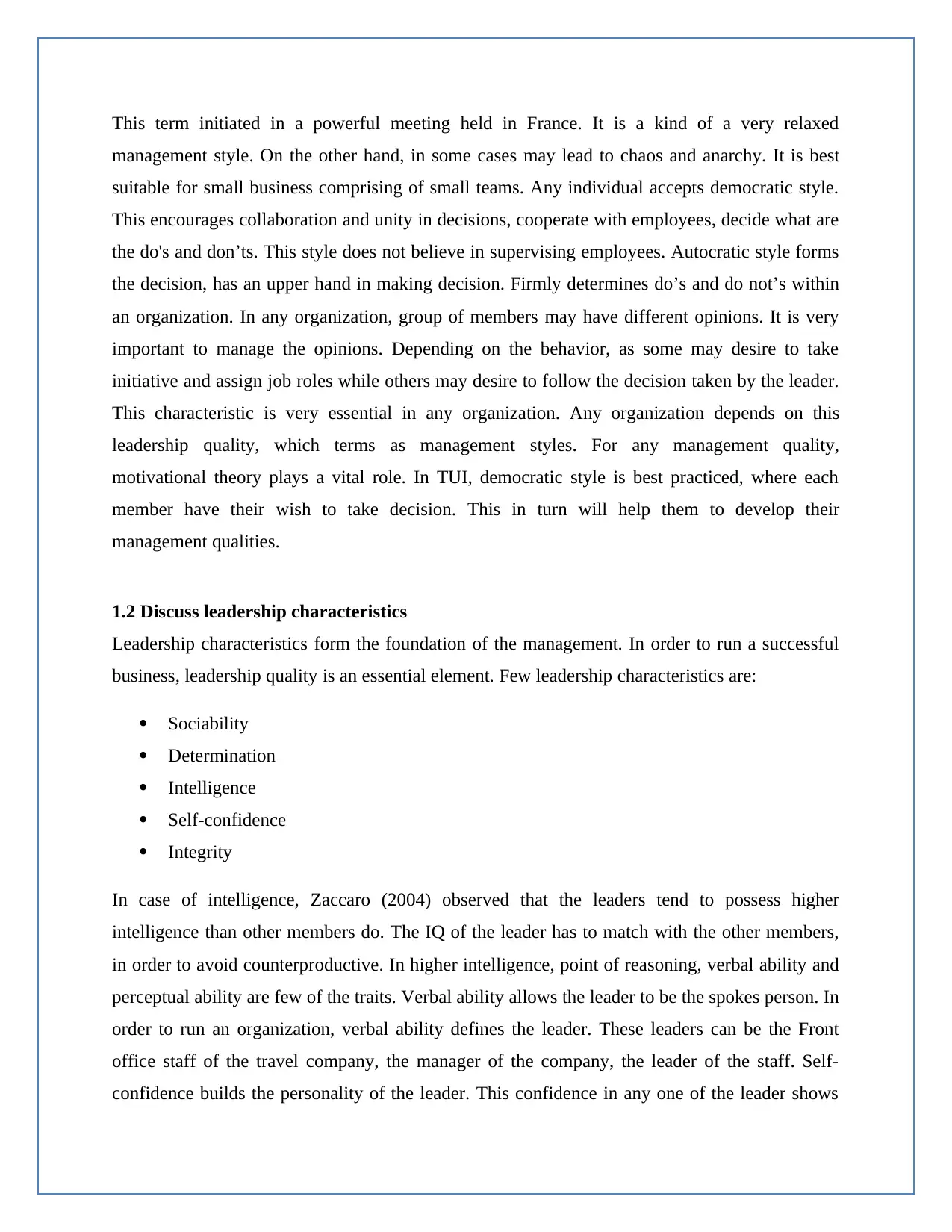
This term initiated in a powerful meeting held in France. It is a kind of a very relaxed
management style. On the other hand, in some cases may lead to chaos and anarchy. It is best
suitable for small business comprising of small teams. Any individual accepts democratic style.
This encourages collaboration and unity in decisions, cooperate with employees, decide what are
the do's and don’ts. This style does not believe in supervising employees. Autocratic style forms
the decision, has an upper hand in making decision. Firmly determines do’s and do not’s within
an organization. In any organization, group of members may have different opinions. It is very
important to manage the opinions. Depending on the behavior, as some may desire to take
initiative and assign job roles while others may desire to follow the decision taken by the leader.
This characteristic is very essential in any organization. Any organization depends on this
leadership quality, which terms as management styles. For any management quality,
motivational theory plays a vital role. In TUI, democratic style is best practiced, where each
member have their wish to take decision. This in turn will help them to develop their
management qualities.
1.2 Discuss leadership characteristics
Leadership characteristics form the foundation of the management. In order to run a successful
business, leadership quality is an essential element. Few leadership characteristics are:
Sociability
Determination
Intelligence
Self-confidence
Integrity
In case of intelligence, Zaccaro (2004) observed that the leaders tend to possess higher
intelligence than other members do. The IQ of the leader has to match with the other members,
in order to avoid counterproductive. In higher intelligence, point of reasoning, verbal ability and
perceptual ability are few of the traits. Verbal ability allows the leader to be the spokes person. In
order to run an organization, verbal ability defines the leader. These leaders can be the Front
office staff of the travel company, the manager of the company, the leader of the staff. Self-
confidence builds the personality of the leader. This confidence in any one of the leader shows
management style. On the other hand, in some cases may lead to chaos and anarchy. It is best
suitable for small business comprising of small teams. Any individual accepts democratic style.
This encourages collaboration and unity in decisions, cooperate with employees, decide what are
the do's and don’ts. This style does not believe in supervising employees. Autocratic style forms
the decision, has an upper hand in making decision. Firmly determines do’s and do not’s within
an organization. In any organization, group of members may have different opinions. It is very
important to manage the opinions. Depending on the behavior, as some may desire to take
initiative and assign job roles while others may desire to follow the decision taken by the leader.
This characteristic is very essential in any organization. Any organization depends on this
leadership quality, which terms as management styles. For any management quality,
motivational theory plays a vital role. In TUI, democratic style is best practiced, where each
member have their wish to take decision. This in turn will help them to develop their
management qualities.
1.2 Discuss leadership characteristics
Leadership characteristics form the foundation of the management. In order to run a successful
business, leadership quality is an essential element. Few leadership characteristics are:
Sociability
Determination
Intelligence
Self-confidence
Integrity
In case of intelligence, Zaccaro (2004) observed that the leaders tend to possess higher
intelligence than other members do. The IQ of the leader has to match with the other members,
in order to avoid counterproductive. In higher intelligence, point of reasoning, verbal ability and
perceptual ability are few of the traits. Verbal ability allows the leader to be the spokes person. In
order to run an organization, verbal ability defines the leader. These leaders can be the Front
office staff of the travel company, the manager of the company, the leader of the staff. Self-
confidence builds the personality of the leader. This confidence in any one of the leader shows
Paraphrase This Document
Need a fresh take? Get an instant paraphrase of this document with our AI Paraphraser
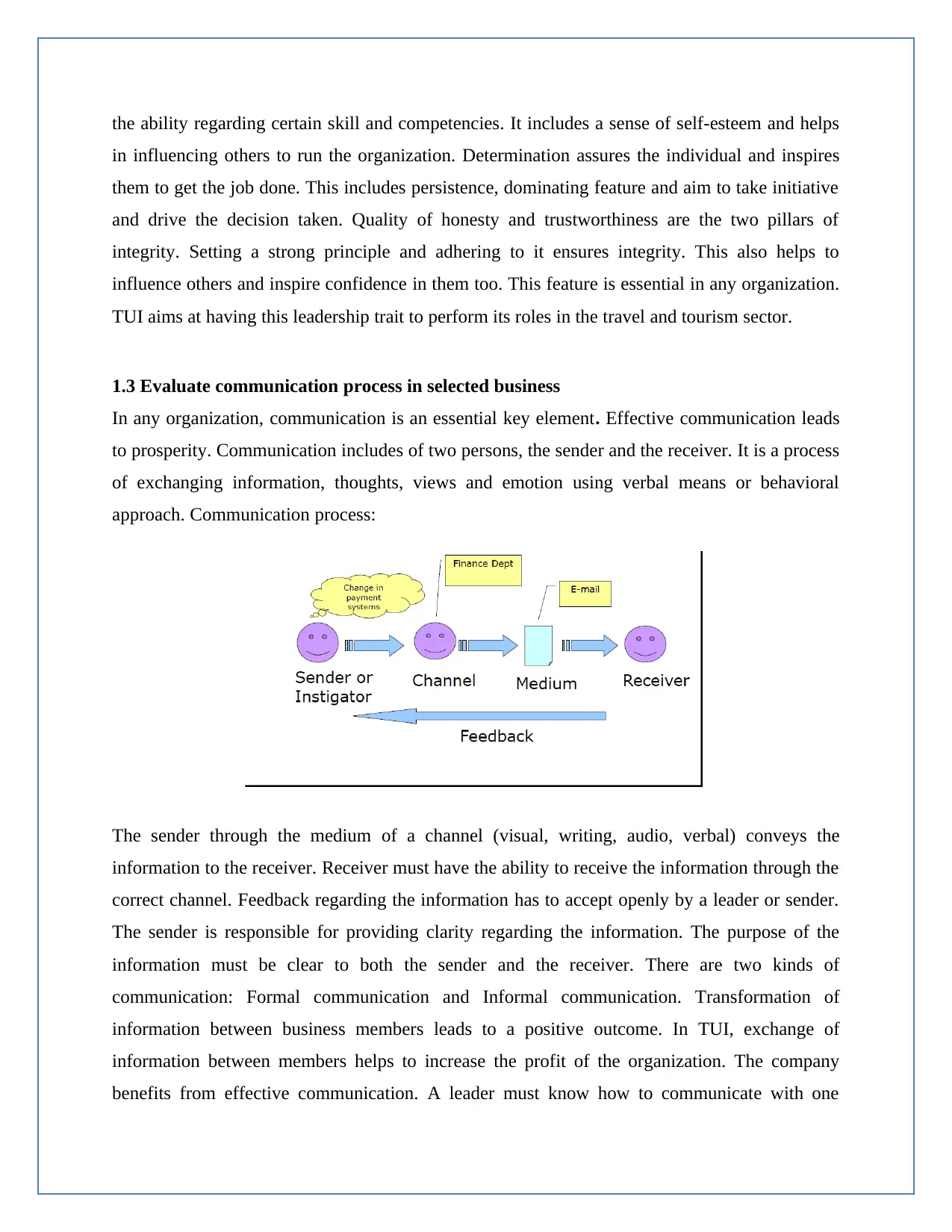
the ability regarding certain skill and competencies. It includes a sense of self-esteem and helps
in influencing others to run the organization. Determination assures the individual and inspires
them to get the job done. This includes persistence, dominating feature and aim to take initiative
and drive the decision taken. Quality of honesty and trustworthiness are the two pillars of
integrity. Setting a strong principle and adhering to it ensures integrity. This also helps to
influence others and inspire confidence in them too. This feature is essential in any organization.
TUI aims at having this leadership trait to perform its roles in the travel and tourism sector.
1.3 Evaluate communication process in selected business
In any organization, communication is an essential key element. Effective communication leads
to prosperity. Communication includes of two persons, the sender and the receiver. It is a process
of exchanging information, thoughts, views and emotion using verbal means or behavioral
approach. Communication process:
The sender through the medium of a channel (visual, writing, audio, verbal) conveys the
information to the receiver. Receiver must have the ability to receive the information through the
correct channel. Feedback regarding the information has to accept openly by a leader or sender.
The sender is responsible for providing clarity regarding the information. The purpose of the
information must be clear to both the sender and the receiver. There are two kinds of
communication: Formal communication and Informal communication. Transformation of
information between business members leads to a positive outcome. In TUI, exchange of
information between members helps to increase the profit of the organization. The company
benefits from effective communication. A leader must know how to communicate with one
in influencing others to run the organization. Determination assures the individual and inspires
them to get the job done. This includes persistence, dominating feature and aim to take initiative
and drive the decision taken. Quality of honesty and trustworthiness are the two pillars of
integrity. Setting a strong principle and adhering to it ensures integrity. This also helps to
influence others and inspire confidence in them too. This feature is essential in any organization.
TUI aims at having this leadership trait to perform its roles in the travel and tourism sector.
1.3 Evaluate communication process in selected business
In any organization, communication is an essential key element. Effective communication leads
to prosperity. Communication includes of two persons, the sender and the receiver. It is a process
of exchanging information, thoughts, views and emotion using verbal means or behavioral
approach. Communication process:
The sender through the medium of a channel (visual, writing, audio, verbal) conveys the
information to the receiver. Receiver must have the ability to receive the information through the
correct channel. Feedback regarding the information has to accept openly by a leader or sender.
The sender is responsible for providing clarity regarding the information. The purpose of the
information must be clear to both the sender and the receiver. There are two kinds of
communication: Formal communication and Informal communication. Transformation of
information between business members leads to a positive outcome. In TUI, exchange of
information between members helps to increase the profit of the organization. The company
benefits from effective communication. A leader must know how to communicate with one

another to run the company smoothly. Communication is effective through various means like
audio, visual, face-to-face interaction, written way to know each other’s issue, group meetings
held at regular weekends. The most effective means of communication is the audio and visual
concept. Communication and motivation goes hand in hand. Better and effective communication
increases motivation among members. They get an opportunity to interact with each other and
raise their issues to reach to a solution. Better communication will enable workers to know each
other’s work and be aware of any loophole. Effective communications ensures:
Commitment from employees
Co-ordination among members
Also ensures that all employees are working to attend the same objective
Communication is effective between leaders and the non-leaders to let the organization run
smoothly. For working effectively, team needs to communicate using the various means. Being
motivated, employers will be able to communicate to their leaders. If they are able to speak up,
they will be able to discuss their issues or suggest ways to improve the structure of the
organization. There are certain barriers in communication, which a leader must communicate to
the other members. Effective communication depends on the ability of the sender understanding
the purpose or context of the message.
1.4 Analyze Organizational culture and change in selected business
Any organization possesses certain structure. This structure is shown in the below diagram
audio, visual, face-to-face interaction, written way to know each other’s issue, group meetings
held at regular weekends. The most effective means of communication is the audio and visual
concept. Communication and motivation goes hand in hand. Better and effective communication
increases motivation among members. They get an opportunity to interact with each other and
raise their issues to reach to a solution. Better communication will enable workers to know each
other’s work and be aware of any loophole. Effective communications ensures:
Commitment from employees
Co-ordination among members
Also ensures that all employees are working to attend the same objective
Communication is effective between leaders and the non-leaders to let the organization run
smoothly. For working effectively, team needs to communicate using the various means. Being
motivated, employers will be able to communicate to their leaders. If they are able to speak up,
they will be able to discuss their issues or suggest ways to improve the structure of the
organization. There are certain barriers in communication, which a leader must communicate to
the other members. Effective communication depends on the ability of the sender understanding
the purpose or context of the message.
1.4 Analyze Organizational culture and change in selected business
Any organization possesses certain structure. This structure is shown in the below diagram
⊘ This is a preview!⊘
Do you want full access?
Subscribe today to unlock all pages.

Trusted by 1+ million students worldwide
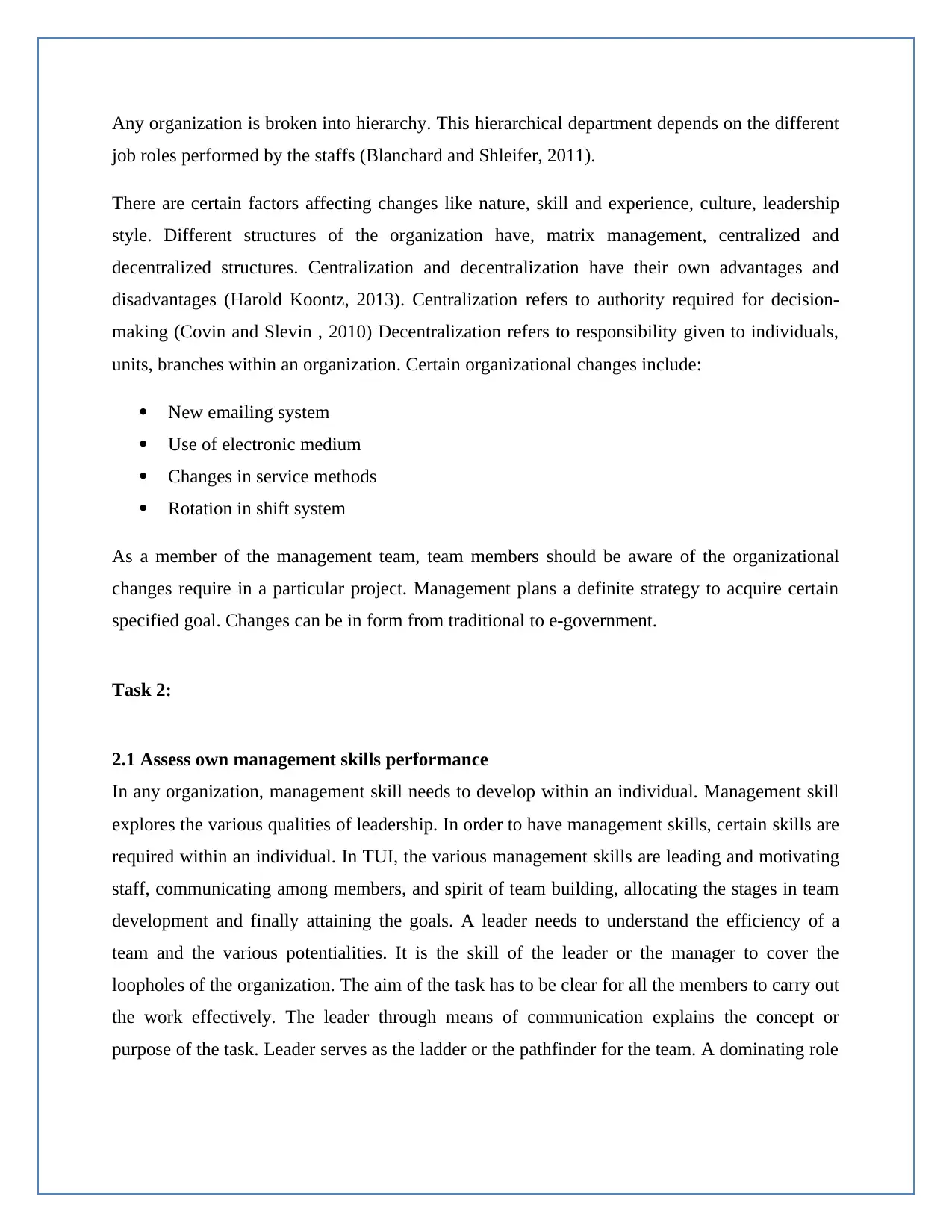
Any organization is broken into hierarchy. This hierarchical department depends on the different
job roles performed by the staffs (Blanchard and Shleifer, 2011).
There are certain factors affecting changes like nature, skill and experience, culture, leadership
style. Different structures of the organization have, matrix management, centralized and
decentralized structures. Centralization and decentralization have their own advantages and
disadvantages (Harold Koontz, 2013). Centralization refers to authority required for decision-
making (Covin and Slevin , 2010) Decentralization refers to responsibility given to individuals,
units, branches within an organization. Certain organizational changes include:
New emailing system
Use of electronic medium
Changes in service methods
Rotation in shift system
As a member of the management team, team members should be aware of the organizational
changes require in a particular project. Management plans a definite strategy to acquire certain
specified goal. Changes can be in form from traditional to e-government.
Task 2:
2.1 Assess own management skills performance
In any organization, management skill needs to develop within an individual. Management skill
explores the various qualities of leadership. In order to have management skills, certain skills are
required within an individual. In TUI, the various management skills are leading and motivating
staff, communicating among members, and spirit of team building, allocating the stages in team
development and finally attaining the goals. A leader needs to understand the efficiency of a
team and the various potentialities. It is the skill of the leader or the manager to cover the
loopholes of the organization. The aim of the task has to be clear for all the members to carry out
the work effectively. The leader through means of communication explains the concept or
purpose of the task. Leader serves as the ladder or the pathfinder for the team. A dominating role
job roles performed by the staffs (Blanchard and Shleifer, 2011).
There are certain factors affecting changes like nature, skill and experience, culture, leadership
style. Different structures of the organization have, matrix management, centralized and
decentralized structures. Centralization and decentralization have their own advantages and
disadvantages (Harold Koontz, 2013). Centralization refers to authority required for decision-
making (Covin and Slevin , 2010) Decentralization refers to responsibility given to individuals,
units, branches within an organization. Certain organizational changes include:
New emailing system
Use of electronic medium
Changes in service methods
Rotation in shift system
As a member of the management team, team members should be aware of the organizational
changes require in a particular project. Management plans a definite strategy to acquire certain
specified goal. Changes can be in form from traditional to e-government.
Task 2:
2.1 Assess own management skills performance
In any organization, management skill needs to develop within an individual. Management skill
explores the various qualities of leadership. In order to have management skills, certain skills are
required within an individual. In TUI, the various management skills are leading and motivating
staff, communicating among members, and spirit of team building, allocating the stages in team
development and finally attaining the goals. A leader needs to understand the efficiency of a
team and the various potentialities. It is the skill of the leader or the manager to cover the
loopholes of the organization. The aim of the task has to be clear for all the members to carry out
the work effectively. The leader through means of communication explains the concept or
purpose of the task. Leader serves as the ladder or the pathfinder for the team. A dominating role
Paraphrase This Document
Need a fresh take? Get an instant paraphrase of this document with our AI Paraphraser

will create chaos and autonomy among the members. Democratic leadership will ensure effective
management in the organization.
Decision-making is an important function of the leader. In Travel and Tourism Company, mainly
in TUI, a leader must ensure that the passengers are in their comfort zone. To help the passengers
from the time of boarding to the time of take off, managers looks after them with the help of
team members. Handling a particular situation is the effectiveness of a leadership trait.
Exchanging information among the various tasks increases the work efficiency. There are four
types of managerial skills:
Human skill
Design skill
Conceptual skill
Technical skill
The various skills required in this sector depend on personal potentiality. Strength will be
possible through willingness to learn about the new techniques, adjustable to the shift timing.
The most important factor is being presentable in approach. Personal planning is needed to carry
on the job role. Scheduling the work enhances the potentiality of a manager.
management in the organization.
Decision-making is an important function of the leader. In Travel and Tourism Company, mainly
in TUI, a leader must ensure that the passengers are in their comfort zone. To help the passengers
from the time of boarding to the time of take off, managers looks after them with the help of
team members. Handling a particular situation is the effectiveness of a leadership trait.
Exchanging information among the various tasks increases the work efficiency. There are four
types of managerial skills:
Human skill
Design skill
Conceptual skill
Technical skill
The various skills required in this sector depend on personal potentiality. Strength will be
possible through willingness to learn about the new techniques, adjustable to the shift timing.
The most important factor is being presentable in approach. Personal planning is needed to carry
on the job role. Scheduling the work enhances the potentiality of a manager.
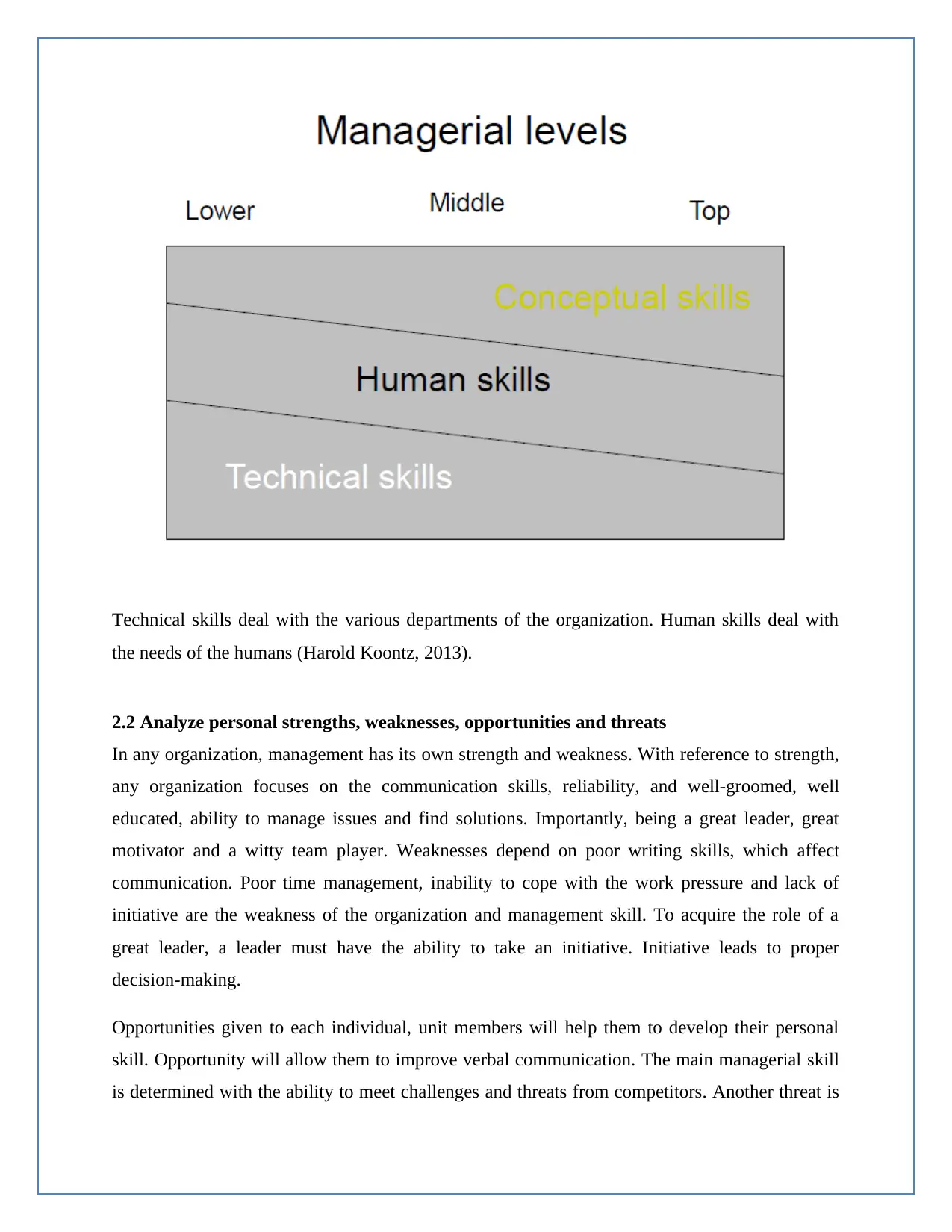
Technical skills deal with the various departments of the organization. Human skills deal with
the needs of the humans (Harold Koontz, 2013).
2.2 Analyze personal strengths, weaknesses, opportunities and threats
In any organization, management has its own strength and weakness. With reference to strength,
any organization focuses on the communication skills, reliability, and well-groomed, well
educated, ability to manage issues and find solutions. Importantly, being a great leader, great
motivator and a witty team player. Weaknesses depend on poor writing skills, which affect
communication. Poor time management, inability to cope with the work pressure and lack of
initiative are the weakness of the organization and management skill. To acquire the role of a
great leader, a leader must have the ability to take an initiative. Initiative leads to proper
decision-making.
Opportunities given to each individual, unit members will help them to develop their personal
skill. Opportunity will allow them to improve verbal communication. The main managerial skill
is determined with the ability to meet challenges and threats from competitors. Another threat is
the needs of the humans (Harold Koontz, 2013).
2.2 Analyze personal strengths, weaknesses, opportunities and threats
In any organization, management has its own strength and weakness. With reference to strength,
any organization focuses on the communication skills, reliability, and well-groomed, well
educated, ability to manage issues and find solutions. Importantly, being a great leader, great
motivator and a witty team player. Weaknesses depend on poor writing skills, which affect
communication. Poor time management, inability to cope with the work pressure and lack of
initiative are the weakness of the organization and management skill. To acquire the role of a
great leader, a leader must have the ability to take an initiative. Initiative leads to proper
decision-making.
Opportunities given to each individual, unit members will help them to develop their personal
skill. Opportunity will allow them to improve verbal communication. The main managerial skill
is determined with the ability to meet challenges and threats from competitors. Another threat is
⊘ This is a preview!⊘
Do you want full access?
Subscribe today to unlock all pages.

Trusted by 1+ million students worldwide

the matter of unemployment. Unemployment overcome with the help of grooming session will
improve management quality. Identifying the strength and weakness helps to cover up the
negative aspects of the company. Knowing the weaknesses of the company enables to overcome
them with the help of the leader. A leader possesses such qualities to influence the organization.
Personal strength includes the capability to manage situations, to identify issues and find
solutions.
Weaknesses are the damaging factors of an organization. The disability to handle chaotic
situation or poor communication will defeat the purpose the leader. Within personal strength
implies understanding the various means of communication skill. They are:
Using skill for keeping conversation going, asking questions effectively will help to
satisfy their queries
Understanding cultural differences, using non verbal messages to communicate with the
leader
Using listening skills will enhance the motive of understanding
Weaknesses occur in larger organization, where communication gets overloaded. Threats from
competitors due to unemployment are one of the major weaknesses. Rivalries and competitors
create the main challenges for a particular organization. Time management includes the scope
and opportunity utilized by a particular staff. Poor time management is one of the weaknesses.
Lack of confidence within one self is a negative trait of leadership. Confidence enables to speak
up, to answer and to motivate. Motivating employees is one of the strength of the leader.
Motivation leads to success and better opportunity for communication. Working as a team is the
strength of the management. In career development, management or leadership trait is an
important feature. Decentralization is another such weakness encounter in development plans. In
order to, improve communication, staff training, keeping short information and even increasing
awareness of language difficulties.
2.3 Set and prioritize objectives and targets to develop own potential
Developing one’s potential is an inner strength of an individual. Setting an objective increases
the work efficiency of an individual (Harold Koontz, 2013). Each member should aim at setting
objective. A definite objective leads to run the organization smoothly. The question comes to
improve management quality. Identifying the strength and weakness helps to cover up the
negative aspects of the company. Knowing the weaknesses of the company enables to overcome
them with the help of the leader. A leader possesses such qualities to influence the organization.
Personal strength includes the capability to manage situations, to identify issues and find
solutions.
Weaknesses are the damaging factors of an organization. The disability to handle chaotic
situation or poor communication will defeat the purpose the leader. Within personal strength
implies understanding the various means of communication skill. They are:
Using skill for keeping conversation going, asking questions effectively will help to
satisfy their queries
Understanding cultural differences, using non verbal messages to communicate with the
leader
Using listening skills will enhance the motive of understanding
Weaknesses occur in larger organization, where communication gets overloaded. Threats from
competitors due to unemployment are one of the major weaknesses. Rivalries and competitors
create the main challenges for a particular organization. Time management includes the scope
and opportunity utilized by a particular staff. Poor time management is one of the weaknesses.
Lack of confidence within one self is a negative trait of leadership. Confidence enables to speak
up, to answer and to motivate. Motivating employees is one of the strength of the leader.
Motivation leads to success and better opportunity for communication. Working as a team is the
strength of the management. In career development, management or leadership trait is an
important feature. Decentralization is another such weakness encounter in development plans. In
order to, improve communication, staff training, keeping short information and even increasing
awareness of language difficulties.
2.3 Set and prioritize objectives and targets to develop own potential
Developing one’s potential is an inner strength of an individual. Setting an objective increases
the work efficiency of an individual (Harold Koontz, 2013). Each member should aim at setting
objective. A definite objective leads to run the organization smoothly. The question comes to
Paraphrase This Document
Need a fresh take? Get an instant paraphrase of this document with our AI Paraphraser
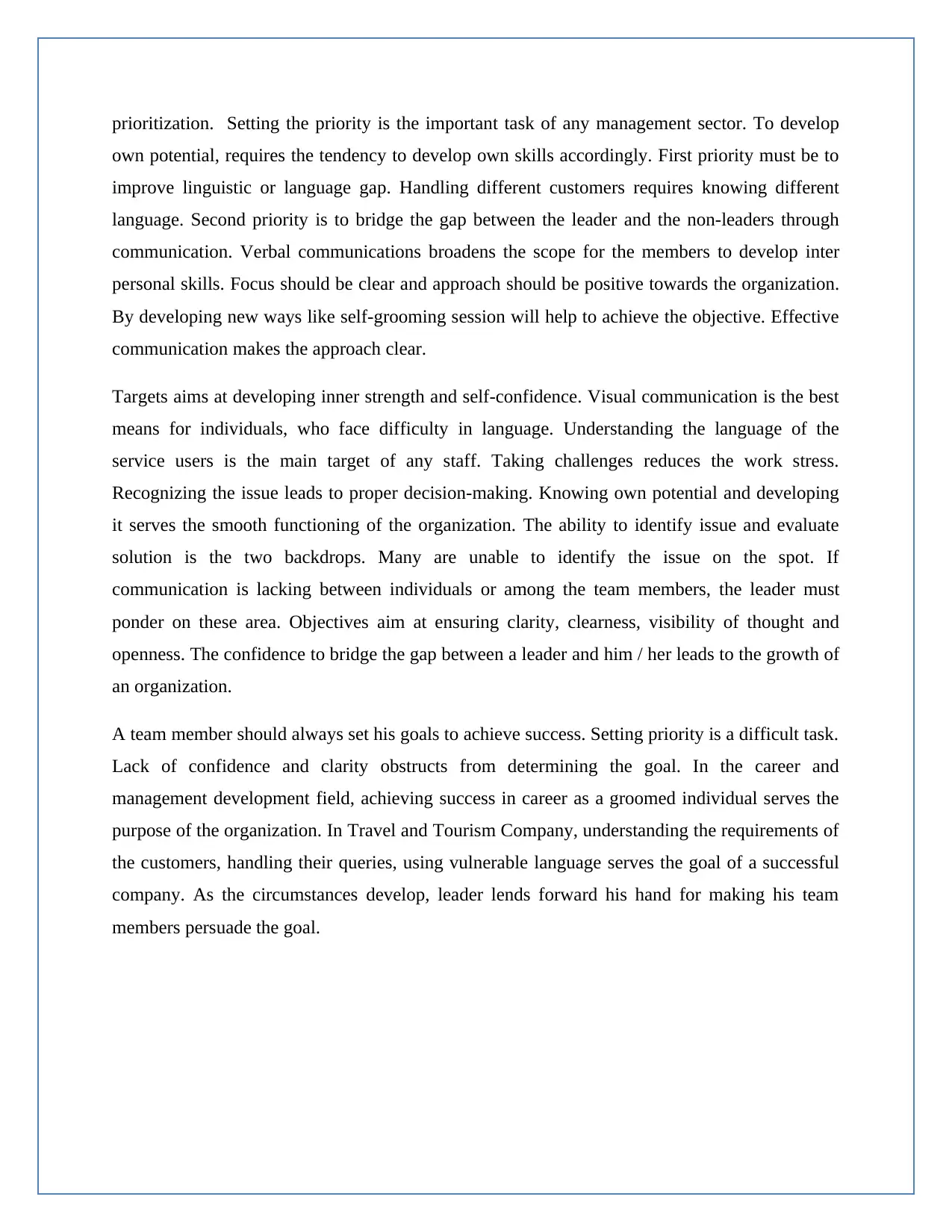
prioritization. Setting the priority is the important task of any management sector. To develop
own potential, requires the tendency to develop own skills accordingly. First priority must be to
improve linguistic or language gap. Handling different customers requires knowing different
language. Second priority is to bridge the gap between the leader and the non-leaders through
communication. Verbal communications broadens the scope for the members to develop inter
personal skills. Focus should be clear and approach should be positive towards the organization.
By developing new ways like self-grooming session will help to achieve the objective. Effective
communication makes the approach clear.
Targets aims at developing inner strength and self-confidence. Visual communication is the best
means for individuals, who face difficulty in language. Understanding the language of the
service users is the main target of any staff. Taking challenges reduces the work stress.
Recognizing the issue leads to proper decision-making. Knowing own potential and developing
it serves the smooth functioning of the organization. The ability to identify issue and evaluate
solution is the two backdrops. Many are unable to identify the issue on the spot. If
communication is lacking between individuals or among the team members, the leader must
ponder on these area. Objectives aim at ensuring clarity, clearness, visibility of thought and
openness. The confidence to bridge the gap between a leader and him / her leads to the growth of
an organization.
A team member should always set his goals to achieve success. Setting priority is a difficult task.
Lack of confidence and clarity obstructs from determining the goal. In the career and
management development field, achieving success in career as a groomed individual serves the
purpose of the organization. In Travel and Tourism Company, understanding the requirements of
the customers, handling their queries, using vulnerable language serves the goal of a successful
company. As the circumstances develop, leader lends forward his hand for making his team
members persuade the goal.
own potential, requires the tendency to develop own skills accordingly. First priority must be to
improve linguistic or language gap. Handling different customers requires knowing different
language. Second priority is to bridge the gap between the leader and the non-leaders through
communication. Verbal communications broadens the scope for the members to develop inter
personal skills. Focus should be clear and approach should be positive towards the organization.
By developing new ways like self-grooming session will help to achieve the objective. Effective
communication makes the approach clear.
Targets aims at developing inner strength and self-confidence. Visual communication is the best
means for individuals, who face difficulty in language. Understanding the language of the
service users is the main target of any staff. Taking challenges reduces the work stress.
Recognizing the issue leads to proper decision-making. Knowing own potential and developing
it serves the smooth functioning of the organization. The ability to identify issue and evaluate
solution is the two backdrops. Many are unable to identify the issue on the spot. If
communication is lacking between individuals or among the team members, the leader must
ponder on these area. Objectives aim at ensuring clarity, clearness, visibility of thought and
openness. The confidence to bridge the gap between a leader and him / her leads to the growth of
an organization.
A team member should always set his goals to achieve success. Setting priority is a difficult task.
Lack of confidence and clarity obstructs from determining the goal. In the career and
management development field, achieving success in career as a groomed individual serves the
purpose of the organization. In Travel and Tourism Company, understanding the requirements of
the customers, handling their queries, using vulnerable language serves the goal of a successful
company. As the circumstances develop, leader lends forward his hand for making his team
members persuade the goal.
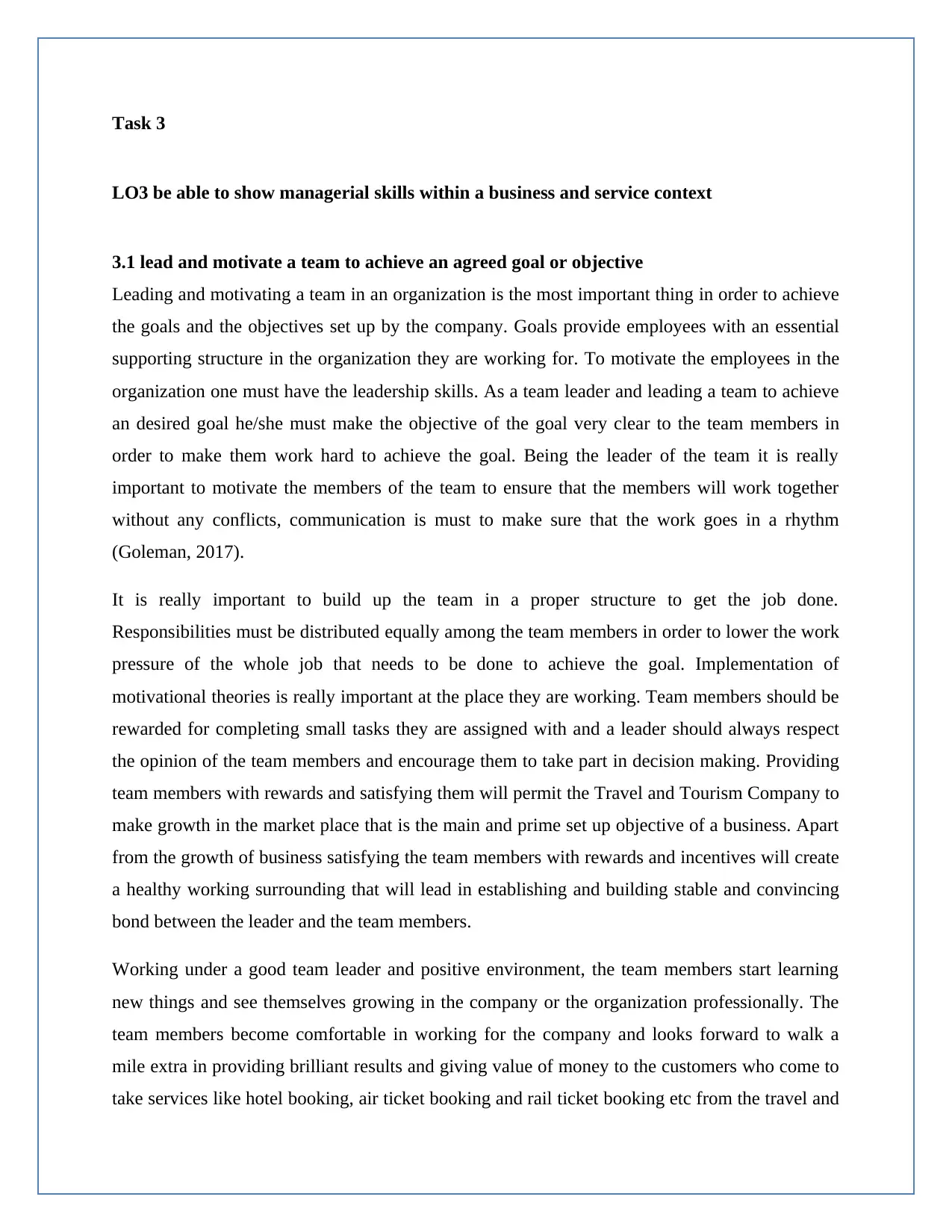
Task 3
LO3 be able to show managerial skills within a business and service context
3.1 lead and motivate a team to achieve an agreed goal or objective
Leading and motivating a team in an organization is the most important thing in order to achieve
the goals and the objectives set up by the company. Goals provide employees with an essential
supporting structure in the organization they are working for. To motivate the employees in the
organization one must have the leadership skills. As a team leader and leading a team to achieve
an desired goal he/she must make the objective of the goal very clear to the team members in
order to make them work hard to achieve the goal. Being the leader of the team it is really
important to motivate the members of the team to ensure that the members will work together
without any conflicts, communication is must to make sure that the work goes in a rhythm
(Goleman, 2017).
It is really important to build up the team in a proper structure to get the job done.
Responsibilities must be distributed equally among the team members in order to lower the work
pressure of the whole job that needs to be done to achieve the goal. Implementation of
motivational theories is really important at the place they are working. Team members should be
rewarded for completing small tasks they are assigned with and a leader should always respect
the opinion of the team members and encourage them to take part in decision making. Providing
team members with rewards and satisfying them will permit the Travel and Tourism Company to
make growth in the market place that is the main and prime set up objective of a business. Apart
from the growth of business satisfying the team members with rewards and incentives will create
a healthy working surrounding that will lead in establishing and building stable and convincing
bond between the leader and the team members.
Working under a good team leader and positive environment, the team members start learning
new things and see themselves growing in the company or the organization professionally. The
team members become comfortable in working for the company and looks forward to walk a
mile extra in providing brilliant results and giving value of money to the customers who come to
take services like hotel booking, air ticket booking and rail ticket booking etc from the travel and
LO3 be able to show managerial skills within a business and service context
3.1 lead and motivate a team to achieve an agreed goal or objective
Leading and motivating a team in an organization is the most important thing in order to achieve
the goals and the objectives set up by the company. Goals provide employees with an essential
supporting structure in the organization they are working for. To motivate the employees in the
organization one must have the leadership skills. As a team leader and leading a team to achieve
an desired goal he/she must make the objective of the goal very clear to the team members in
order to make them work hard to achieve the goal. Being the leader of the team it is really
important to motivate the members of the team to ensure that the members will work together
without any conflicts, communication is must to make sure that the work goes in a rhythm
(Goleman, 2017).
It is really important to build up the team in a proper structure to get the job done.
Responsibilities must be distributed equally among the team members in order to lower the work
pressure of the whole job that needs to be done to achieve the goal. Implementation of
motivational theories is really important at the place they are working. Team members should be
rewarded for completing small tasks they are assigned with and a leader should always respect
the opinion of the team members and encourage them to take part in decision making. Providing
team members with rewards and satisfying them will permit the Travel and Tourism Company to
make growth in the market place that is the main and prime set up objective of a business. Apart
from the growth of business satisfying the team members with rewards and incentives will create
a healthy working surrounding that will lead in establishing and building stable and convincing
bond between the leader and the team members.
Working under a good team leader and positive environment, the team members start learning
new things and see themselves growing in the company or the organization professionally. The
team members become comfortable in working for the company and looks forward to walk a
mile extra in providing brilliant results and giving value of money to the customers who come to
take services like hotel booking, air ticket booking and rail ticket booking etc from the travel and
⊘ This is a preview!⊘
Do you want full access?
Subscribe today to unlock all pages.

Trusted by 1+ million students worldwide
1 out of 19
Related Documents
Your All-in-One AI-Powered Toolkit for Academic Success.
+13062052269
info@desklib.com
Available 24*7 on WhatsApp / Email
![[object Object]](/_next/static/media/star-bottom.7253800d.svg)
Unlock your academic potential
Copyright © 2020–2025 A2Z Services. All Rights Reserved. Developed and managed by ZUCOL.





